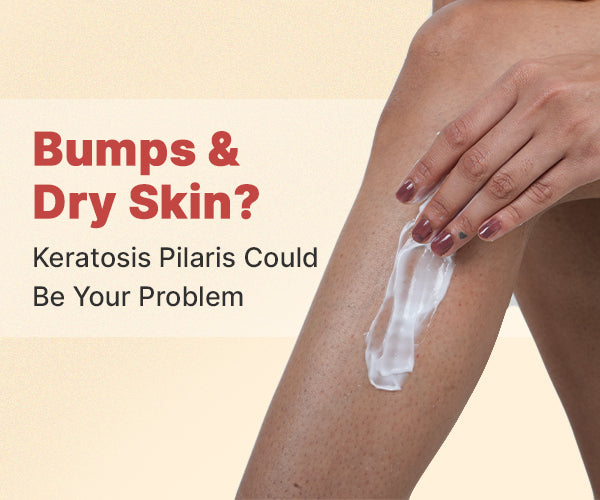I have Chicken Skin!
My skin looks like a strawberry!
Why is my elbow so bumpy?
We have all been there. Keratosis Pilaris or KP affects 1 in 3 of the adult population. We all have it. Most of us notice it. What can we do about it?
What is Keratosis Pilaris?
Without going into too much detail, KP is a harmless skin condition that causes dry, rough patches and tiny bumps on the upper arms, calves, thighs and buttocks. Usually caused by dead skin cells that are not shed effectively.
What causes it?
Nothing! . It is just one of those annoying things that is passed on by our ancestors in our genes, aggravated by sun exposure and friction to the skin.
Popular myths around KP
● You need to scrub more : Our skin is a Gentle organ that needs to be handled
very gently. Not scrubbed like a dirty floor. Nope, harsh scrubs usually tend to
increase the condition and also make the area darker.
● Eating meat causes it : We Indians have listened to this time and time again.
Becoming Vegetarian is the cure for everything. Nope, Being Vegetarian or
vegan or gluten free doesn't have anything to do with KP.
● There is no Treatment for it : While KP cannot be cured, It can be managed
effectively and with regular maintenance, nobody including you will see or feel
your KP for the foreseeable future. Let us help you out.
What can I do about it?
With Regular care, KP can be managed effectively giving you soft glowing skin.
It all comes down to some basic skin discipline.
4 steps to manage KP to get flat smooth skin
● Us a gentle cleanser or a gentle scrub that's not too harsh on the skin
● Use a AHA and BHA based cream like our Rough repair BHA cream twice daily
on affected areas
● Avoid Sun exposure on affected areas by either wearing a sunscreen or covering
with clothes
● Avoid abrasion to the areas while doing everyday tasks like working out.
Bonus Tip
Be Consistent. You can reduce the use of the Rough Repair BHA Cream to once every alternate day after the condition subsides and you are happy with your results, but the other steps have to be followed on a daily basis.
And for the love of skin, Don’t listen to the WhatsApp medics and scrub your skin like a fry pan or become a vegetarian for KP. KP is a friend who will stay with you throughout your life. You just have to keep her calm and cool. While She chills, You can #Siezeyoursexy with Active Topicals.
My skin looks like a strawberry!
Why is my elbow so bumpy?
We have all been there. Keratosis Pilaris or KP affects 1 in 3 of the adult population. We all have it. Most of us notice it. What can we do about it?
What is Keratosis Pilaris?
Without going into too much detail, KP is a harmless skin condition that causes dry, rough patches and tiny bumps on the upper arms, calves, thighs and buttocks. Usually caused by dead skin cells that are not shed effectively.
What causes it?
Nothing! . It is just one of those annoying things that is passed on by our ancestors in our genes, aggravated by sun exposure and friction to the skin.
Popular myths around KP
● You need to scrub more : Our skin is a Gentle organ that needs to be handled
very gently. Not scrubbed like a dirty floor. Nope, harsh scrubs usually tend to
increase the condition and also make the area darker.
● Eating meat causes it : We Indians have listened to this time and time again.
Becoming Vegetarian is the cure for everything. Nope, Being Vegetarian or
vegan or gluten free doesn't have anything to do with KP.
● There is no Treatment for it : While KP cannot be cured, It can be managed
effectively and with regular maintenance, nobody including you will see or feel
your KP for the foreseeable future. Let us help you out.
What can I do about it?
With Regular care, KP can be managed effectively giving you soft glowing skin.
It all comes down to some basic skin discipline.
4 steps to manage KP to get flat smooth skin
● Us a gentle cleanser or a gentle scrub that's not too harsh on the skin
● Use a AHA and BHA based cream like our Rough repair BHA cream twice daily
on affected areas
● Avoid Sun exposure on affected areas by either wearing a sunscreen or covering
with clothes
● Avoid abrasion to the areas while doing everyday tasks like working out.
Bonus Tip
Be Consistent. You can reduce the use of the Rough Repair BHA Cream to once every alternate day after the condition subsides and you are happy with your results, but the other steps have to be followed on a daily basis.
And for the love of skin, Don’t listen to the WhatsApp medics and scrub your skin like a fry pan or become a vegetarian for KP. KP is a friend who will stay with you throughout your life. You just have to keep her calm and cool. While She chills, You can #Siezeyoursexy with Active Topicals.


Leave a comment
This site is protected by reCAPTCHA and the Google Privacy Policy and Terms of Service apply.